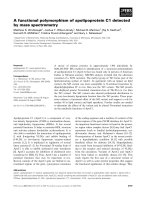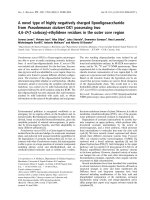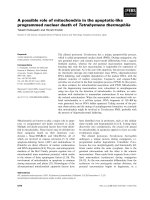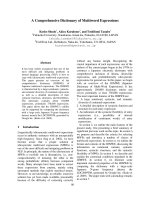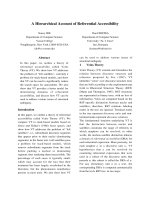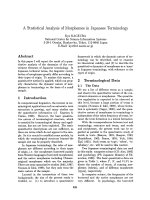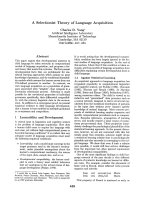Báo cáo khoa học: "A Functional Semantics of Natural Language Grammar" pot
Bạn đang xem bản rút gọn của tài liệu. Xem và tải ngay bản đầy đủ của tài liệu tại đây (731.26 KB, 10 trang )
Inquiry Semantics:
A Functional Semantics of Natural Language Grammar 1
William C. Mann
USC/Information Sciences Institute
4676 Admiralty Way
Marina del Rey, California 90292
USA
Summary
Programming a computer to operate to a significant
degree as an author is a challenging research task. The
creation of fluent multiparagraph text is a complex
process because knowledge must be expressed in
linguistic forms at several levels of organization,
including paragraphs, sentences and words, each of
which involves its own kinds of complexity.
Accommodating this natural complexity is a difficult
design problem. To solve it we must separate the
various relevant kinds of knowledge into nearly
independent collections, factoring the problem.
Inquiry semantics is a new factoring of the text
generation problem. It is novel in that it provides a
distinct semantics for the grammar, independent of
world knowledge, discourse knowledge, text plans and
the lexicon, but appropriately linked to each. It has
been implemented as part of the Nigel text generation
grammar of English.
This paper characterizes inquiry semantics, shows
how it factors text generation, and describes its
exemplification in NigeL The resulting description of
inquiries for English has three dimensions: the
varieties of operations on information, the varieties of
information operated upon, and the subject matter of
the operations. The definition framework for inquiries
involves both traditional and nontraditional linguistic
abstractions, spanning the knowledge to be
represented and the plans required for presenting it.
1
Introduction
Text generation is
the generation of language to
conform to an a priori intention and plan to communicate.
The problem of text generation is naturally complex, requiring the
1previous title: Generating Text: Knowledge a Grammar Demands.
This research was SUl~ported by the Air Force Office of Scientific Research
contract No, F49620-79-C-0181. The views and conclusions contained in this
document are those of the author and should not be interpreted as necessarily
representing the official policies or endorsements, either expressed or implied, of
Ihe Air Force Office of Scientific Research of the U.S Government.
active coordination of many kinds of knowledge having
independent origins and character. A significant part of this
complexity is in grammatical knowledge. It is important for the
grammar of a text generator to have its own integrity, yet without
being operationally autonomous. 2
The methods of generating text presented
here
grew out of
a concern to maintain the integrity and definitional independence
of particular existing fragments of grammar. These methods
employ the grammar in ways which do not make any strong
assumptions about the nongrammatical kinds of knowledge in the
text generator. They control the use of the grammar in
generation.
We-first describe the methods, showing how they make
grammatical generation possible. Then we show how they factor
the problem of text generation and clarify the role of knowledge
representations. Finally we characterize inquiry semantics and
the notion of meaning.
2 Grammar and Control
People often anticipate that
a
text generator will plan the
operations of the grammar in full detail and then execute such
plans. In fact, such a mode of operation has serious difficulties,
and so it is worthwhile to consider other approaches. Even given
the definition of a grammar and a particular way of manipulating it
to produce text, there is an issue of where the initiative should be
exercised
in generation. Should the responsibility for conformity
of ',he result to the given intention and plan lie within Ihe grammar
manipulator, i.e., be part of its process of employing the grammar,
or are the details of grammar use preplanned? It is an issue of
control.
2This role of intention in the use of language is one of the reasons for calling the
semantics in this paper a
functional
semantics Another is our uSe of one of the
"functional" linguistic traditions
165
To see the problem more clearly we can compare
controlling the grammar to steering a car.
If we intend to drive to a nearby store, we can
imagine planning the trip (in terms of steering motions)
in total detail, deciding just where to turn, change
lanes, and so forth, with sufficient precision to insure
success. This detailed plan could in principle then be
used to steer the car to the store. Such methods of
imposed control
are practical only in very simple
cases.
Alternatively, we can make the decisions about
steering
at the point of need,
on demand.
Unanticipated conditions are thus allowed for, and the
complexity of the task is reduced. (There is no need to
compensate in the plan for tire pressures, for example.)
At each significant point along the way, the driver
chooses a direction that conforms to the goal of
reaching the destination. This is an
active
conformity
approach, in which decisions about
direction are made while the trip is in progress.
With imposed control, information about how to satisfy the
intention and plan is needed before the process is started. With
active conformity, information is needed as the process proceeds.
The design of our generation methods is based on active
conformity. The grammar demands the information it needs about
the plan as generation proceeds.
What does
a
purposefully generating grammar need to
know? As part of the development of the Penman text-generation
;,,~gr~m,
we have created a large systemic grammar of Englis h
iMann 83]. Penman is designed to create a text plan and then
execute it by giving it, one sentential element at a time, to the
grRmmar. The grammar, which is called Nigel, operates on its own
initiative, requesting information about the planned text as it is
needed. The central organizing concept in the grammar is
choice.
The language offers a variety of grammatical options that
:?,~ !~ represented as sets of alternatives, and means for
producing surface forms from particular combinations of choices
made among the alternatives. All syntactic options are expressed
in the sets of alternatives. In any one set, choosing one option
excludes all of the others. Nigel contains over 200 systems
(collections of alternatives in systemic notation), along with
provisions for realizing choices as structures, an experimental
lexicon used to give the structures surface forms, and extensive
provisions for experimental control. 3
Given this orientation toward choice, the problem of
conformity to the text plan is simply the problem of making
appropriate choices. Each set of alternatives (each
"system" in
its systemic representation
has an associated
chooser
or
choice
expert,
a process that embodies a method for choosing
appropriately in any particular circumstance.
The choice experts require certain information as they
proceed with text generation. Nigei's choice experts request this
information by presenting
inquiries
to the
environment
(the
place outside of the grammar where intentions and plans to
communicate are found.) For this purpose, Nigel employs a
formal
inquiry language
in which an inquiry is an expression
containing an
inquiry operator
and a sequence of
operands. A
single
interface
is provided for all interactions between Nigel and
the environment; all interactions at the interface are in the inquiry
language. This way of using such an interface is called
inquiry
semantics.
In this framework, we can understand the demands of the
grammar by understanding the inquiry operators.
3
Varieties of Demands
This section characterizes the demands for information
that Nigel can make in generating sentences. Since Nigel
demands information only by presenting inquiries, we first "
characterize the things that Nigel can inquire about (the operands
of inquiries), then characterize in two different ways the questions
that Nigel can ask.
3.1 Categories of Operands of Inquiries
Nigel has four related information forms:
1. Concept symbols
2. Presentation specifications
3. Term sets
4. Terms
Concept symbols
are names assigned by the
environment to particular elements of its knowledge, either in the
text plan for the text being formed or in the environment's
knowledge base. A concept symbol represents an entity that may
be simple or complex, decomposable or not; the symbols
3The grammar is written in an extended systemic notation and draws extensively
on precedents in the work of Halliday and others [Berry 75, Berry 77. Halliday &
Hasan 76, Halliday 76, Hudson 76, Halliday & Martin 81,de Joia & $tenton
80. Fawcett 80]. We gratefully acknowledge the participation of Michael Halliday
and Christian Matthiessen in the work.
166
themselves are not decomposable. A concept symbol does not
have to bear any particular relationship to any kind of
linguistic
entity.
Presentation specifications are
formal descriptions of
the information that should be expressed in a particular reference,
description, or predication. Through presentation specifications
the environment designates the content to be conveyed in each
~rt.icular constituent, (but not how the content is to be
expressed.)
For nominal groups (NP's). for example, presentation
specifications represent the identification of the content to
present about the particular object, process, or relation which the
nominal group represents. The collection of devices that express
nominal group content include head terms (nouns, pronouns,
substitute "one"), modifying nominals, adjectives and adjective
groups, quantifiers, numerals, determiners, prepositional phrases,
restrictive and nonrestrictive relative clauses. Normally the
grammar will use some combination of these devices in the
nominal group to express all of the content of the presentation
specification.
As a minimal example, the grammar's decision on whether
a pronoun is adequate as a referring phrase can be made on the
basis of the presentation specification, since the specification tells
what constitutes adequate reference at the point of referring. (If
the presentation specification indicates that nothing beyond
gender and number needs to be expressed, a pronoun is used.)
The presentation specification is thus a unifying device for
all of the conceptual elements of an intention to refer. It is
essential to the generation task because the various syntactic
devices effectively compete for the content which the nominal
group expresses in referring.
At the clause level, presentation specifications operate
comparably, unifying the effects of adverbial, conjunctive, and
clausal modifiers. The specifications are constructed units, not
frames or delimited regions of knowledge.
Term sets
are collections of lexical items created in a
special way which insures that they are appropriate, in denotation,
:cmnotation, and information content, for their intended use. (The
,~;=cess
which creates term sets does not restrict them
syntactically; that is done later by the grammar.) The individual
terms in a term set need not be so restrictive that they fully express
the intent of the unit being constructed, since they are used with
modifiers. Term sets are not like sets of synonyms since they do
not have any uniformity of semantic content.
Term sets are used as collections of alternatives, from
which one term will be picked for the final syntactic unit. The best
example is a term set giving alternatives that can serve as the
head term of a nominal group.
A Term
is a single lexical item selected from a term set. It
identifies the particular lexical item to appear in the generated
text. Currently Nigel is deliberately underdeveloped in its
treatment of lexical items, having no morphological component at
all. Hence terms are simply lexical items which bear lexical
features that the grammar can employ for selectivity.
To see how these forms are used, consider the sentence:
The leader is John.
It refers to John twice. In generating this sentence, the
same concept symbol, say JLDR, would be used to generate both
;f the references. However, two different presentation
specifications for referring to JLDR would be created. The first
might specify that the resulting expression should convey the fact
that the individual holds the role of leader. The second could
merely specify that the resulting expression should convey the
person's name.
Two different term sets would also be created. Initially,
each would contain conceptually and denotationally appropriate
terms, possibly including "leader," "man," and "person," in one
cf *.he term sets, and "John," and "Mr. Jones" in the other. Under
guidance from various inquiries, the grammar applies different
selectivity to one term set than to the other, so that the terms
"leader" and "John" are finally selected.
How do these operands of inquiries compare with
conventional linguistic abstractions?
Concept symbols have many precedents, and terms are
familiar. Both presentation specifications and term sets are new.
As we will see, both presentation specifications and term sets are
widely and frequently used in the grammar. Their central role in
generation suggests that they are worthy of linguistic attention.
167
Presentation specifications are novel in that they represent
the content of particular units without its allocation to constituent
units. This permits the investigation of how the allocation works,
and in particular how differing ranks compete for representational
roles. Competition among the possible consitiuents of a nominal
group for representation of posession seems to be a typical case.
We would like to know, for example how the decision between
using the determiner "his," the prepositional phrase "of his," and
the clause "which he has" is made. A presentation specification
can say in a syntactically neutral way that possession is to be
expressed. Using them facilitates study of the alternation.
Nigel uses subtractive operations on presentation
specifications to account for the fact that repeated expression of
content in a nominal group is marked, but single expression is not.
~.,, it can account for the perception that "his car. which he owns"
is marked in a way in which "his car, which he hates" is not.
Term sets are novel in that they represent the alternations
and :ompetition among lexical items. The sets of terms which
compete as candidates, e.g. for the main verb of a clause or head
term of a nominal group, are highly variable and dependent on the
~'.ubj~ct matter of the communication. Hence they are not
susceptible to static analysis as part of the grammar, and they are
not easy to represent in systemic systems.
Consider, for example, the word "attention" at the end of
the third paragraph back. Other candidates for use in the same
setting would include words such as "research." "curiosity,"
"work." "perusal." and "funds." These terms (as well as
"attention") would all be in the term set for generating that
nominal group. However, they are from different lexical fields,
fields which are ordinarily not in alternation. Since they are not
the basis of a stable alternation, many sorts of static
representations of them (including representation in systems in a
systemic lexico-grammar) seem inappropriate. The situation is
much more complex and dynamic, worthy of linguistic attention.
Notice that in both cases, addition of a new formal
c3:~struct will facilitate study of how particular expressions are
related to closely related alternatives in ways which are not in
~.~po3ition in a conventional systemic account. Studies of
functional alternation have long been a highly valued activity
among systemicists.
Notice also that these constructs arise easily, almost
;nevitably, in studies of text construction, but are not inevitable at
all in descriotive studies of text. Given a particular text to study, it
=s not at all clear what the rejected head term candidates were, nor
what the alternate allocations of content to syntactic units might
have been. In systemic terms, part of the meaning of a nominal
g,ouo is derived from the particular choice of the head term. but,
working descriptively, the alternation is hard to characterize.
Study of text generation (and related work on constructive
characterization) thus complements other methodologies in that it
n, ~.=.s certain difficult tasks easier.
3.2 Abstract Categories of Inquiry Operators
The inquiries of the grammar can be differentiated
according to categories of purposes they serve. Five such
categories are described below. The first two kinds of inquiries
~ ~ :.'~-ed for control, and the last three extract symbols from the
environment either lexical items or symbols that can be included
as subject matter in subsequent inquiries. Inquiries of the first two
kinds have predetermined closed sets of possible responses: the
last three kinds allow an unlimited number of responses.
1. information availability
2. information characterization
3.
decomposition
4, linking (identification of related information)
5.
mapping
Some inquiries determine whether information of a certain
character is
available,
such as the location or duration of an
event. These inquiries generally precede others used to
characterize information.
The operators used for
information characterization
form the largest collection of operators among the five kinds.
They are used to subcategorize and also to discover relations of
inclusion, identity, precedence, adjacency, and attributes of
manner, number, completeness, intended emphasis, identifiability
to the reader, decomposability, gender, hypotheticality,
extensionality, and many other sorts.
When the grammar has determined that some of the
available informaion is decomposable into parts in a syntactically
significant way (usually through information availability inquiries),
information decomposition
inquiries are used to obtain access
168
to the parts. This is the largest category of inquiries for which an
unlimited diversity of responses is allowed. These inquiries offer
access to actors, affected objects, processes, causers, polarities,
locations, time periods, extents, manners, and various kinds of
participants or conditioners of processes.
The
linking inquiries
are a small collection of inquiries
which resemble the information decomposition inquiries. They
obtain information related in a particular way to known
information, but not part of it. For example, given an event whose
time must be expressed, there is an inquiry that obtains the
identity of the time relative to which the event's time of occurrence
should be expressed.
In terms of the four forms of information presented in
section 3.1 above, exploration always proceeds from concepts to
presentation specifications and term sets, and from term sets to
terms, as shown in Figure 1.
Concepts
,/ ,
Presentation Specifications Term Sets
Terms
Figure
1: Information flow through mapping inquiries
A small collection of
Mapping
inquiries participate in this
:~,ploration at the points where information forms change.
Several create specialized presentation specifications for
concepts, and others create term sets and terms.
Since operators can request presentation specifications,
they can in effect demand that the environment work out what
information to include in a new reference to an entity. The
e,~vironment must then use the knowledge of past mentions, a
model of the hearer's attention and of possible confusion
candidates, and also the knowledge of denotationally appropriate
le.<ic.~l items; these elements of knowledge are all outside the
ooundary of the grammar. The mapping from concepts to
presentation specifications is thus dependent on the particular
circumstances.
In
a
similar way, the mappings from concepts to term sets
and from term sets to terms also vary depending on the
comm,mication situation.
3.3
Categories of Subject
Matter
Recurrent topics and categories of subject matter in the
inquiries reflect the syntactically encoded categories Of
knowledge in English. The subject matter categories form two
groups:
1. Elements of knowledge that typically exist odor to the
intention or plan to communicate (described in
section 3.3.1 below), and
2. Elements of knowledge ~:r~ated as Dad of pursuing
the intention or plan to communicate (described in
section 3.3.2 below.)
These are called the
Knowledge Base
and the
Text
Plan,
respectively.
Surprisingly, we do not see any sharing of inquiries
between these two kinds of knowledge. In Nigel, we find that each
inquiry operator addresses solely one body of knowledge or the
other. A few of the categories of operations address both kinds of
knowledge, notably inquiries about availability of information.
Within the categories, however, each individual inquiry is
specialized to a single kind of knowledge.
3.3.1 Subject Matter
of Inquiries Concerning Prior
Knowledge
In addition to inquiring about availability of information, the
grammar asks about abstract characteristics of processes, about
number and discreteness, and about time and space. Also, there
is ~ substantial collection of inquiries about logical relations such
as set membership, interval inclusion, identity of two entities,
extensionality, definiteness of existence, hypotheticality, polarity
and conditionality.
3.3.2 Subject Matter of
Inquiries for
Communication
Among the inquiry operators that refer to information
created in pursuit of an intention or plan to communicate, there
are inquiries about speech acts and about controlling the hearer's
attention. The latter are used in controlling thematicity, various
kinds of marking, and the foregrounding or backgrounding of
information.
3.4
Support Processes in the
Environment
The organization of inquiry requires that various kinds of
processes be available in the environment for responding to
inquiries. At a detailed level, there must be a capability for the
169
environment to recognize each inquiry operator and to respond to
each one appropriately. In computational terms, for a particular
domain of expressive problems, all of the inquiry operators which
are called upon to serve that domain must be implemented. (For
simple expressive problems this can be far fewer than the total for
the grammar.)
At a more comprehensive level, we can identify certain
recurrent activities which must underlie the operations of the
inquiry operator implementations. These include searching for an
appropriate set of.lexical items (such as candidate head nouns for
a nominal group), creating a presentation specification for
expressing a particular idea, and choosing among a set of terms
which the grammar has approved as appropriate for a certain use.
At an even more comprehensive level, the grammar relies
or; the prior activity of processes which plan the
text.
a, Inquiries in
Action: An example
The following list summarizes Nigel's activity in developing
a particular nominal group: "her appointment on Wednesday
morning with us." The starting point is identification of a need to
refer to an object represented by concept APPOINTMENT. At the
end of the activity shown, there is a structure containing the word
"appointment" as the head term, the word "her" as its determiner,
and elements that could be further developed into the phrases "on
Wednesday morning" and "with us." The category of each
inquiry operator is indicated in <brackets>. The order of
presentation is the order actually used in the program. It is
somewhat disconnected, since the program often Chooses in an
arbitrary way between several things which it could do next. An
inquiry appears more than once if it is used by more than one
choice expert.
1. Obtain a presentation specification for
APPOINTMENT <mapping>
developing the head term of the group
2. Obtain a set of candidate head terms <mapping>
3. Establish that APPOINTMENT is countable
<characterization>
4. Classify APPOINTMENT as
<characterization>
5. Classify APPOINTMENT as unitary <characterization>
extensional
6. Classify APPOINTMENT as not a question variable
<characterization>
7. Classify APPOINTMENT as extensional (as part of
pronoun control) <characterization>
8. Classify APPOINTMENT as unitary (as part of pronoun
control) <characterization>
9. Establish that the gender of APPOINTMENT is known
<availability>
10. Establish that in the presentation specification of
APPOINTMENT, there is more to be expressed than
gender and number <characterization>
11. Determine that it is preferab!e to exclude proper
nouns from the term set, rather than exclude the
remainder <preference>
begin developing the determiner
12. Establish that APPOINTMENT is extensional (for
determiner control) <characterization>
13. Establish that APPOINTMENT is identifiable to the
reader <characterization>
resume developing the head term
14. Have the environment select a term, here
"appointment," from among the terms that survived
syntactic selectivity <mapping>
developing the modifiers of the head term
15. Establish that the presentation specification for
APPOINTMENT does not indicate that color, location,
use, substance, size, place of origin or age should be
expressed (7 inquiries) <characterization>
developing the accompaniment modifier
16. Establish that some kind of accompaniment of
APPOINTMENT should be expressed
<characterization>
17. Obtain a symbol (WITHUS) representing the
accompaniment knowledge to be expressed
<decomposition>
complete development of the head term
18. Determine that the speaker wants the hearer to pay
more than minimal attention to APPOINTMENT (thus
cutting off further investigation of a substitution of
"one" for "appointment") <characterization>
developing the time period modifier
19. Establish that the presentation specification of
APPOINTMENT indicates that a time constraint
should be expressed <characterization>
20.
Obtain a symbol (ONWEDNESDAYMORN)
:eprasenting the time constraint to be expressed
<decomposition>
resume developing the determiner
170
21. Establish that no information about the proximity of
APPOINTMENT should be expressed
<characterization>
22. Establish that information about the possessor of
APPOINTMENT should be expressed
<characterization>
23. Obtain a symbol (JANE) representing the possessor of
APPOINTMENT <decomposition>
24. Establish that JANE is unitary <characterization>
25. Establish that JANE does not represent a question
variable <characterization>
26. Obtain a symbol (SELF) representing the speaker
<decomposition>
27. Obtain a symbol (PUBLIC) representing the hearer of
the entire nominal group <decomposition>
28. Establish that SELF is not identical with or included in
JANE <characterization>
29. Establish that PUBLIC is not identical with or included
in JANE <characterization>
30. Establish that the gender of JANE is known
<availability>
31. Establish that the gender of JANE is female
<characterization>
finish developing the modifiers
32.5stablish that there is no residue of unexpressed
content in the presentation specification
<characterization;>
Using the answers to these inquiries, the grammar builds a
structure consisting of four elements in an ordered sequence:
"her," "appointment," ONWEDNESDAYMORN,
WITHUS.
the latter two representing conceptual elements tO be further
developed in subsequent applications of the grammar.
5
Relations between Operators
Some operators are closely related in ways not suggested
above. In particular, some pairs of operators are used together in
a characteristic way: First an availability operator asks if certain
information is available, for example, whether the location of an
event is known. If a positive response is given, a decomposition
inquiry asks for a symbol to represent the available information,
such as the location.
Almost all of the decomposition inquiries are paired with
availability inquiries in this way. However, a few are not. For
these, the grammar assumes the existence and separability of the
information it requests The following are the exception cases:
1. the identity of the speaker.
2. the identity of the time of speaking, the "now" of
tense.
3. given an event to express in an independent clause,
the identity of the time of occurrence of the event.
4. given the need to generate a clause, the identity of the
process portion (which will be realized in the main
verb.)
In addition, none of the mapping operators and none of the
linking operators are paired. We see that the decomposition
operators have little intellectual content, but the other kinds all
contribute significantly.
6 Demands on the Knowledge
Representation
Reviewing the inquiries, we can find several kinds of
operations that are particularly difficult to support in explicit
knowledge representations such as those currently used in AI or
logic.
One operator asks whether the existence of a particular
entity is hvoothetical. Knowledge gained from this inquiry is useful
in controlling contrasts such as the following:
If they run to town, they will be sorry.
If they are running to town, they will be sorry.
Another operator asks about conjectural existence. It
controls contrasts such as:
They will run to town.
They might run to town.
In the first case the running to town is treated as definite
but occurring in the future.
Another asks whether an action to be expressed is habitual
recurrent rather than a particular instance. Another group of
inquiries seeks to determine the manner of performance of an
action. Others deal with partial specifications and "question
171
variables" of the sort that are often realized by "wh" terms such
as "what," "how," and "whether." Some operators control
negation and quantification, which often cause representation
problems.
In addition to all of these potential problem sources,
associated with inquiries whose responses will be difficult to
determine, there are also many difficulties which do not arise from
difficulties of representation. For example, knowing what to
thematize and what to mark, knowing causes and beneficiaries,
knowing which of several lexical items to use (after passing all
syntactic and semantic tests), knowing what relations can be
expressed as possession, knowing whether the reader is able to
identify an entity in memory (for definite determination),
discriminating near from far. all present difficulties without
appearing to stress the capabilities of modern knowledge
representations.
Thus the inquiries can be used as an indication of what
sorts of expansion a knowledge representation needs and as a
guide to the ways in which current knowledge of discourse is
inadequate to support text generation programming.
7
Factoring the Text Generation Problem
Inquiry semantics separates the problem of designing a
text generator into parts which seem much more approachable
than the problem as a whole. The grammar is separated from the
environment by a tight interface which does not allow the
grammar to access any elements of the environment directly. The
inquiries are defined in a syntactically neutral or pre-syntactic
form; answering them never requires knowledge of the syntax of
the language being generated. As a result, the environment and
the grammar can develop independently. This is particularly
important today, since the technologies of the environment are
very unstable, and we would like to be able to use a grammar in
con!unction with several styles of knowledge representation.
The environment is divided into the Knowledge Base and
Text Plan parts, an informal but potentially very useful distinction.
It tends to facilitate independent development of discourse
planning methods. Truth-functional issues seem to be related
largely to the Knowledge Base.
The treatment of the lexicon separates a variety of lexical
phenomena in separate, controlled ways: denotational
appropriateness, syntactic features, and nonsyntactic
.~onde=~otational attributes such as frequency and register, each
receive distinctive treatment in NigeL
8The Abstract Character of Inquiry
Semantics
In this section we compare inquiry semantics to other kinds
of semantics, and also identify the nature of meaning in this
framework.
8.1 Comparative
Semantics
The inquiry-based semantics presented here contrasts
with other accounts also called "semantics" in many ways, but it
does not particularly compete with them. This semantics, as a way
of theorizing, is an answer to the question "How can we
characterize the circumstances under which it is appropriate to
make each particular grammatical choice of a language?"
It differs from other semantic approaches in that
1. its scope is confined to grammar, rather than
addressing linguistic behavior as a whole;
2. it does not presume particular structures (deep or
otherwise) in the environment;
3. it is not particularly limited to issues reducible to
questions of truth value;
4. its scope includes nondeclarative, noninterrogative
speech actions (including imperative, imprecation,
and greeting functions) on a par with declarative and
interrogative ones;
5. it includes other functions of language in addition to
the representational ones (such as the
attention.direction functions);
6. it is defined relative to generation rather than
interpretation, but is not thereby "generative".
This semantics is potentially compatible with other sorts,
since it makes very few theoretical assumptions about the nature
of language and communication. By encompassing every kind of
syntactic construction, it is more inclusive than most.
Nothing in inquiry semantics rules out any particular formal
apparatus as the notation for the methods by which the
environment responds to inquiries. Accounts of particular
languages and grammars will give some informal guidance as to
which sorts of methods will be perspicuous, and may rule out
particular formalisms as response mechanisms for particular
grammars. The topic is as yet unexplored.
172
8.2 The Nature of Meaning in inquiry Semantics
We could assign meanings to any of several kinds of
entities in this framework: grammatical features, collections of
features, realizations of collections of features (i.e., structures),
inquiry responses or other possibilities. Our selection of a
particular kind of entity as the locus of meaning depends on our
intended use for that locus. We intend to use this notion of
meaning to identify the ways in which minimal structurally-justified
.~istinctives are responsive to their conditions of use. This
selection does not preclude other selections for other purposes,
and it certainly does not suggest that there are no other entities
which are meaningful.
We associate meanings with qrammal; qa feature~, in part
because these are the controlling entities in the systemic
framework. Given a systemic grammar, the syntactic structures
~',nicn are produced depend entirely on the grammatical features
which are chosen, and the opportunity to choose a grammatical
feature also depends entirely on the grammatical features which
are chosen, i.e., the entry conditions of the system in which "the
feature occurs. So it is convenient to associate meaning with
features, and to derive meanings for any other entity by the
determinate derivational methods which the systemic framework
provides.
To state the meaning of a grammatical feature is to state
the technical circumstances under which the feature is chosen.
We identify these circumstances as the set of possible collections
of inquiry responses which are sufficient to lead to the choice of
the feature. The definitions of the systems of the grammar and
their choice experts are thus sufficient to determine the meaning
of every grammatical feature. 45 Ambiguity of a feature arises when
there is more than one collection of relevant inquiry responses
which leads to the choice of the feature.
Differences of meaning reflect differences between
collections of inquiry responses. In Nigel, for the features Singular
and Plural, one of the collections of inquiry responses which leads
4We do not stats the method here, since that involves many systemic details, but
it is normally a rather straightforward matter for the Nige! grammar• More detail
can be found in [Mann 82, Mann & Matthiessen 83a, Mann & Matthiessen 8,3b].
5The meanings of the features are not sufficient to find the sets of meanings
which corres~ond to particular structures, since that requires the realization
mapping of featureS to structureS. However, given the associations of features
with realization operations, the structures for which a particular feature (or
combination of features) is chosen can be identified, and so in principle the sets of
techincal circumstances which can yield a particular string can be identified.
to Singular contains a response "unitary" to MultiplicityQ, and a
corresponding collection contains "multiple" as a response to
MultiplicityQ, which leads to Plural. We can determine by
inspection of the entire meanings that Singular and Plural exclude
each other, and the determination could be made even if the
features were not in direct opposition in the grammar.
Notice that this approach is compatible with approaches to
grammar other than traditional systemic grammar, provided that
their optionality is reexpressed as alternation of features, with
choice experts defined to identify the circumstances under which
each option is chosen.
Notice also that it is possible to have meanings in the
~irammar which
are
ruled out by the environment, for example, by
consistency conditions. A change in the environment's
epistemology could lead to changes in how the grammar is
employed, without changes in meaning, the grammar being more
neutral than its user.
Notice also that the collection of inquiry operators for a
language is a claim concerning the semantic range of the
grammar of that language, a characterization of what can be
exDresssd syntactically.
Notice finally that, given a grammar and an inquiry
semantics of each of two different languages, the question of
whether a particular sentence of one language has the same
meaning as a particular sentence of the other language is an
addressable question, and that it is possible in principle to find
cases for which the meanings are the same. One can also
investigate the extent to which a particular opposition in one
language is an exact translation of an opposition in another.
9
Conclusions
The inquiry language as a level of abstraction provides a
useful factoring of the text generation problem, isolating the
grammar-intensive part.
Development of inquiry language has led to the creation of
new kinds of abstract elements that can be the operands of
i;~quiries. Of these, presentation specifications and term sets have
sufficiently novel scopes to suggest that they may be useful in
defining relationships between grammar and language use.
We have identified three dimensions of characterization
that yield a convenient abstract structure for understanding
inquiry language collectively (by categories of operands,
173
categories of operators and categories of subject matter.) These
categorizations clarify the ways in which effective use of a
grammar depends on processes and information outside of the
grammar, including some ways which are not well controlled in
available knowledge representations.
Inquiry semantics contrasts with other theoretical entities
I.
also called "semantics" in many ways. It is potentially compatible
with some other forms, but tends to be broader than many in
including non-representational functions and non-declarative
speech actions in its scope.
Refe
rences
[Berry 75] Berry, M., Introduction to Systemic Linguistics:
Structures and Systems. B. T. Batsford, Ltd., London, 1975.
[Berry 77] Berry, M., Introduction to Systemic Linguistics: Levels
and Links, B. T. Batsford, Ltd., London, 1977.
[de Joia & Stenton 80] de Joia, A., and A. Stenton, Terms in
Systemic Linguistics, Batsford Academic and Educational,
Ltd., London, 1980.
[Fawcett 80] Fawcett, R., Cognitive Linguistics and Social
Interaction, Julius Groos Vertag and Exeter University Press,
1980.
[Hailiday 76] Halliday, M. A. K., System and Function in Language,
Oxford University Press. London. 1976.
[Halliday & Hasan 76] Halliday. M. A. K and R. Hasan. Cohesion
in English, Longman, London, 1976. English Language
Series, Title No. 9.
[Haltiday & Martin 81] Halliday, M.A.K., and J. R. Martin (eds.),
Readings in Systemic Linguistics, Batsford, London, 1981.
[Hudson 76] Hudson, R. A., Arguments for a
Non-Transformational Grammar, University of Chicago Press,
Chicago, 1976.
[Mann 82] Mann, W. C., The Anatomy of a Systemic Choice,
USC/Information Sciences Institute, Marina del Rey, CA,
Technical Report RR-82-104, October 1982. To appear in
~iscourse Processes
[Mann 83] Mann, William C°, An Overview of the Penman Text
Generation System, USC information Sciences Institute,
Marina del Rey, CA 90291., Technical Report RR.8,3.114,
1983. To appear in the 1983 AAAI Proceedings.
[Mann & Matthiessen 83a] Mann, W. C., and C. M. I. M.
Matthiessen, Nigeh A Systemic Grammar for Text Generation,
USC/Information Sciences Institute, RR-83.105, February
1983. The papers in this report will also apoear in a
forthcoming volume of the Advances in Discourse Processes
Series, R. Freedle (ed.): Systemic Perspectives on Discourse:
Selected Theoretical Papers from the 9th International
Systemic Workshop to be published by Ablex.
[Mann & Matthiessen 83b] Mann, William C. and Christian M. I.
M. Matthiessen, An Overview of the Nige/ Text Generation
Grammar, USC Information Sciences institute, Marina del
Rey, CA 90291., Technical Report RR-8,3-113, 1983.
174
